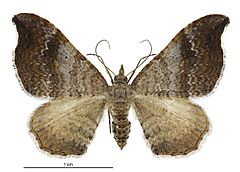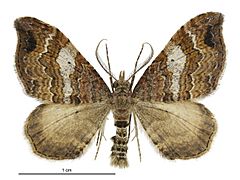Homodotis megaspilata facts for kids
Quick facts for kids Homodotis megaspilata |
|
|---|---|
 |
|
| Female | |
 |
|
| Male | |
| Scientific classification | |
| Kingdom: | |
| Phylum: | |
| Subphylum: | |
| Class: | |
| Order: | |
| Family: | |
| Genus: |
Homodotis
|
| Species: |
H. megaspilata
|
| Binomial name | |
| Homodotis megaspilata (Walker, 1862)
|
|
| Synonyms | |
|
|
Homodotis megaspilata is a fascinating type of moth that belongs to the Geometridae family. These moths are special because they are endemic to New Zealand, meaning you can only find them living naturally in New Zealand and nowhere else in the world!
How This Moth Got Its Name
The study of how living things are named and grouped is called taxonomy. This particular moth was first given a scientific name in 1862 by a scientist named Francis Walker. He called it Larentia megaspilata.
Later, in 1875, other scientists like Baron Cajetan von Felder, Rudolf Felder, and Alois Friedrich Rogenhofer also described this moth. They gave it different names: Cidaria assata and Cidaria nehata. However, another scientist named Edward Meyrick realized in 1883 that these were all the same species. He then made sure the moth was known by its original name, Homodotis megaspilata.
Where This Moth Lives
The Homodotis megaspilata moth is quite common throughout New Zealand. This means you can find it in many different parts of the country.
What This Moth Looks Like
The Homodotis megaspilata moth can look very different from one moth to another. This is called being variable in appearance.
- Size: These moths are usually medium-sized.
- Colors: Their wings often have a mix of brown, grey, and sometimes yellowish or reddish tones.
- Patterns: You might see interesting patterns on their wings, like wavy lines, spots, or bands. These patterns help them blend in with their surroundings.
- Males vs. Females: As you can see in the pictures, the male and female moths can look a bit different. Females often have broader wings and slightly different markings compared to the males.

